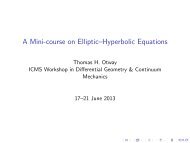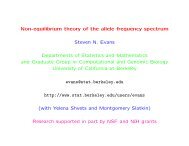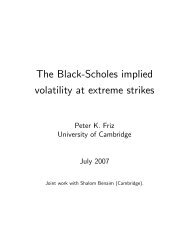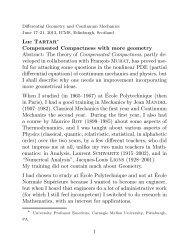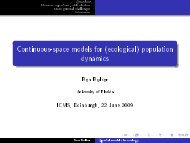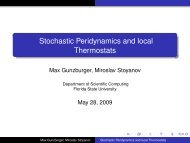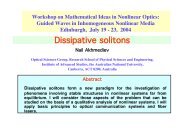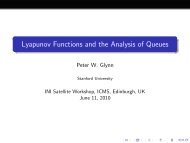1. Introduction We are going to investigate the equation ut(t, x ... - ICMS
1. Introduction We are going to investigate the equation ut(t, x ... - ICMS
1. Introduction We are going to investigate the equation ut(t, x ... - ICMS
- No tags were found...
Create successful ePaper yourself
Turn your PDF publications into a flip-book with our unique Google optimized e-Paper software.
18Theorem 3.4. For any γ,ν,p,θ,b, <strong>the</strong>re exist a constant c 0 > 0 suchthat, for any c ≥ c 0 , <strong>the</strong> opera<strong>to</strong>r(−L b,c ) γ : H 2γ+νp,θ→ H ν p,θis bounded and, for any u ∈ H γ+νp,θ,wehave||u|| 2γ+ν,p,θ ≤ N||(−L b,c ) γ u|| ν,p,θ ≤ N||u|| 2γ+ν,p,θ . (3.2)The main difficulty of <strong>the</strong> <strong>the</strong>ory is that ∆ and L b,c do not comm<strong>ut</strong>e.Theorem 3.5. For any b, γ, p, and θ, <strong>the</strong> opera<strong>to</strong>r L b,0 is <strong>the</strong> genera<strong>to</strong>rof an analytic semigroup T bt acting in H γ p,θ .Notice that, if d =1, <strong>the</strong> <strong>the</strong>orem is quite simple. Indeed,(D 2 +(b − 1)D)(v(e x )) = (L b,0 v)(e x ),so that <strong>the</strong> properties of <strong>the</strong> semigroup related <strong>to</strong> L b,0 can be easily obtained from <strong>the</strong>well-known properties of <strong>the</strong> semigroup related <strong>to</strong> <strong>the</strong> opera<strong>to</strong>r D 2 +(b − 1)D withconstant coefficients. However, for d ≥ 2, we do not know any easy way <strong>to</strong> deal withL b,0 .




